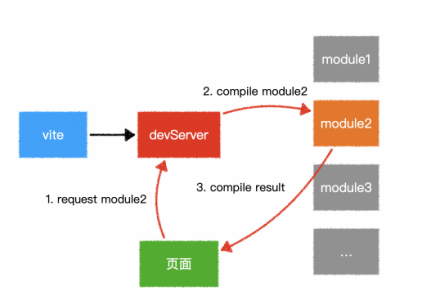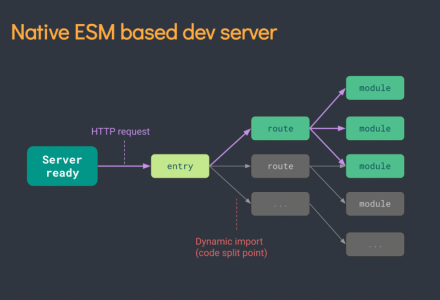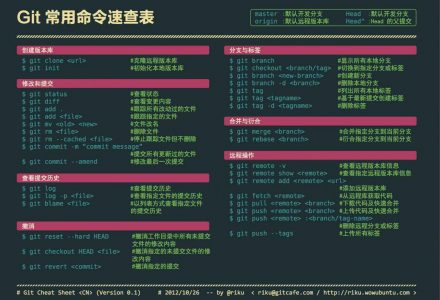Vue3.0部分知识点
项目目录结构
|-node_modules -- 所有的项目依赖包都放在这个目录下
|-public -- 公共文件夹
---|favicon.ico -- 网站的显示图标
---|index.html -- 入口的html文件
|-src -- 源文件目录,编写的代码基本都在这个目录下
---|assets -- 放置静态文件的目录,比如logo.pn就放在这里
---|components -- Vue的组件文件,自定义的组件都会放到这
---|App.vue -- 根组件,这个在Vue2中也有
---|main.ts -- 入口文件,因为采用了TypeScript所以是ts结尾
---|shims-vue.d.ts -- 类文件(也叫定义文件),因为.vue结尾的文件在ts中不认可,所以要有定义文件
|-.browserslistrc -- 在不同前端工具之间公用目标浏览器和node版本的配置文件,作用是设置兼容性
|-.eslintrc.js -- Eslint的配置文件,不用作过多介绍
|-.gitignore -- 用来配置那些文件不归git管理
|-package.json -- 命令配置和包管理文件
|-README.md -- 项目的说明文件,使用markdown语法进行编写
|-tsconfig.json -- 关于TypoScript的配置文件
|-yarn.lock -- 使用yarn后自动生成的文件,由Yarn管理,安装yarn包时的重要信息存储到yarn.lock文件中
1. package.json三个命令
{
"scripts": {
"serve": "vue-cli-service serve", 在开发时用于查看效果的命令,视频中演示看一下效果
"build": "vue-cli-service build", 打包打码,一般用于生产环境中使用
"lint": "vue-cli-service lint" 检查代码中的编写规范
},
开发环境 devDependencies 编写代码、测试代码、修改 Bug。也就说这些代码没有上线。
测试环境 dependencies 就是代码已经上线,放到了正式的服务器上。
}
2. main.ts文件
import { createApp } from "vue"; // 引入vue文件,并导出`createApp`
import App from "./App.vue"; // 引入自定义组件,你在页面上看的东西基本都在这个组件里
createApp(App).mount("#app"); // 把App挂载到#app节点上,在public目录下的index.html找节点
setup() ref()
setup() //代替data和method返回数据和方法,在beforeCreate、created之前执行
setup()函数的用法,可以代替 Vue2 中的 date 和 methods 属性,直接把逻辑卸载 setup 里就可以
ref 函数的使用,它是一个神奇的函数,要在template中使用的变量,必须用ref包装一下。
return出去的数据和方法,在模板中才可以使用,这样可以精准的控制暴漏的变量和方法。
defineComponent重载函数
<script lang="ts">
import { defineComponent, ref } from "vue";
export default defineComponent({
name: "App",
setup() {
const aa = ref(["11", "22", "33"]); //无初始值设置为null
return {
aa
};
<!-- const divs = ref([])
组件挂载后,即能通过divs.value获取遍历元素的所有dom
return{
divs
} -->
},
});
</script>
```html
# reactive()函数优化
reactive()函数接收一个普通对象,返回一个响应式的数据对象。用户数据生成代理对象,从而实现监控用户数据改变的目的。
```html
<script lang="ts">
import { ref, reactive } from "vue";
export default {
name: "App",
setup() {
const data = reactive({
const aa = ref(["11", "22", "33"]);
});
return {
data,
};
},
};
</script>
ref(),reactive() //定义vue2.0中data和method方法
toRefs()优化
toRefs()函数可以将reactive()创建出来的响应式对象,转换为普通对象,只不过这个对象上的每个属性节点,都是ref()类型的响应式数据
toRefs() //使用拓展用算符…的方法返回数据data
import { reactive, toRefs } from "vue";
export default {
name: "App",
setup() {
const data: DataProps = reactive({
const aa = ref(["11", "22", "33"]);
});
const refData = toRefs(data);
return {
...refData,
};
},
};
watch-监听器(侦听器)
(1)不会立即执行,当侦听的源变更时才会执行
(2)可以监听多个数据源
import {… , watch} from “vue” 引入后编写watch函数,它接受两个参数,第一个是要监听的值overText,然后是一个回调函数。在函数中你可以获得到新知和老值。
定义一个方法
使用watch同样需要先进行导入.
import { watch } from 'vue'
const overAction = () => {
overText.value = overText.value;
};
return { overAction};
}
watch(aa, (newValue, oldValue) => {
document.title = newValue;
});
如果监听多个值
watch([overText, () => data.select], (newValue, oldValue) => {
console.log(`new--->${newValue}`);
console.log(`old--->${oldValue}`);
document.title = newValue[0];
});
vue3生命周期
setup() :开始创建组件之前,在beforeCreate和created之前执行。创建的是data和method
onBeforeMount() : 组件挂载到节点上之前执行的函数。
onMounted() : 组件挂载完成后执行的函数。
onBeforeUpdate(): 组件更新之前执行的函数。
onUpdated(): 组件更新完成之后执行的函数。
onBeforeUnmount(): 组件卸载之前执行的函数。
onUnmounted(): 组件卸载完成后执行的函数
onActivated(): 被包含在<keep-alive>中的组件,会多出两个生命周期钩子函数。被激活时执行。
onDeactivated(): 比如从 A 组件,切换到 B 组件,A 组件消失时执行。
onErrorCaptured(): 当捕获一个来自子孙组件的异常时激活钩子函数(以后用到再讲,不好展现)。
注:使用组件会将数据保留在内存中,比如我们不想每次看到一个页面都重新加载数据,就可以使用组件解决。
先列举5个常用得
<script lang="ts">
import {
reactive,
toRefs,
onMounted,
onBeforeMount,
onBeforeUpdate,
onUpdated,
} from "vue";
const app = {
name: "App",
setup() {
const data: DataProps = reactive({
const aa = ref(["11", "22", "33"]);
});
onBeforeMount(() => {
console.log("2-组件挂载到页面之前执行-----onBeforeMount()");
});
onMounted(() => {
console.log("3-组件挂载到页面之后执行-----onMounted()");
});
onBeforeUpdate(() => {
console.log("4-组件更新之前-----onBeforeUpdate()");
});
onUpdated(() => {
console.log("5-组件更新之后-----onUpdated()");
});
const refData = toRefs(data);
return {
...refData,
};
},
};
export default app;
结果:
1 - 开始创建组件---- - setup();
2 - 组件挂载到页面之前执行---- - onBeforeMount();
3 - 组件挂载到页面之后执行---- - onMounted();
4 - 组件更新之前---- - onBeforeUpdate();
5 - 组件更新之后---- - onUpdated();
vue2得生命周期在vue3 也可以用 但是不愿混用
你可以在setup()函数之后编写Vue2的生命周期函数,代码如下:
beforeCreate() {
console.log("1-组件创建之前-----beforeCreate()");
},
beforeMount() {
console.log("2-组件挂载到页面之前执行-----BeforeMount()");
},
mounted() {
console.log("3-组件挂载到页面之后执行-----Mounted()");
},
beforeUpdate() {
console.log("4-组件更新之前-----BeforeUpdate()");
},
updated() {
console.log("5-组件更新之后-----Updated()");
},
Vue2.x 与 Vue3.x的生命周期钩子函数
Vue2--------------vue3
beforeCreate -> setup()
created -> setup()
beforeMount -> onBeforeMount
mounted -> onMounted
beforeUpdate -> onBeforeUpdate
updated -> onUpdated
beforeDestroy -> onBeforeUnmount
destroyed -> onUnmounted
activated -> onActivated
deactivated -> onDeactivated
errorCaptured -> onErrorCaptured
钩子函数的使用
1. onRenderTracked直译过来就是状态跟踪——-散弹枪
它会跟踪页面上所有响应式变量和方法的状态,也就是我们用return返回去的值,他都会跟踪。只要页面有update的情况,他就会跟踪,然后生成一个event对象,我们通过event对象来查找程序的问题所在。
使用onRenderTracked同样要使用import进行引入。
import { .... ,onRenderTracked,} from "vue";
引用后就可以在setup()函数中进行引用了。
onRenderTracked((event) => {
console.log("状态跟踪组件----------->");
console.log(event);
});
在组件没有更新的时候onRenderTracked是不会执行的,组件更新时,他会跟组里边每个值和方法的变化。
2. onRenderTriggered直译过来是状态触发——-狙击枪
它不会跟踪每一个值,而是给你变化值的信息,并且新值和旧值都会给你明确的展示出来。
import { .... ,onRenderTriggered,} from "vue";
onRenderTriggered()函数,写在setup()函数里边,
onRenderTriggered((event) => {
console.log("状态触发组件--------------->");
console.log(event);
});
对 event 对象属性的详细介绍:
- key 那边变量发生了变化
- newValue 更新后变量的值
- oldValue 更新前变量的值
- target 目前页面中的响应变量和函数
vue3模块化
1. 新建一个ts文件
直接上代码,在src目录下,新建一个文件夹host(所有抽离出来的功能模块都可以放到这个文件夹里),然后再新建一个ts文件
import { ref } from "vue"; //在代码的最前面用import进行引入ref
const nowTime = ref("00:00:00");
const getNowTime = () => {
const now = new Date();
const hour = now.getHours() < 10 ? "0" + now.getHours() : now.getHours();
const minu =
now.getMinutes() < 10 ? "0" + now.getMinutes() : now.getMinutes();
const sec =
now.getSeconds() < 10 ? "0" + now.getSeconds() : now.getSeconds();
nowTime.value = hour + ":" + minu + ":" + sec;
setTimeout(getNowTime, 1000);
};
export { nowTime, getNowTime } //,在最后用export的方式
2.APP.vue页面
引入代码:
<template>
<div>
<div>{{ nowTime }}</div>
<div><button @click="getNowTime">显示时间</button></div>
</div>
</template>
<script lang="ts">
import { nowTime, getNowTime } from "./host/useNowTime"
import {
defineComponent,
ref,
} from 'vue';
export default defineComponent({
name: 'App',
components: {
},
setup() {
return{
nowTime,getNowTime
}
}
});
</script>
简单的弹框组件
1.在/src/components/目录下,创建一个Dialog.vue的组件
<template>
<div id="center">
<h2>显示的内容</h2>
</div>
</template>
<script lang="ts">
export default {};
</script>
<style>
#center {
width: 200px;
height: 200px;
border: 2px solid black;
background: white;
position: fixed;
left: 50%;
top: 50%;
margin-left: -100px;
margin-top: -100px;
}
</style>
2.在App.vue中使用
import modal from "./components/Dialog.vue";
const app = {
name: "App",
components: {
Dialog,
},
}
Suspense组件的使用
使用方法一:<Suspense></Suspense>与插槽配合
Suspense是有两个template插槽的,第一个default代表异步请求完成后,显示的模板内容。fallback代表在加载中时,显示的模板内容。
1.1定义组件
<template>
<h1>{{result}}</h1>
</template>
<script>
export default {
name: "NewModel",
setup(){
return new Promise((resolve)=>{
setTimeout(()=>{
return resolve({result:"OK"})
},3000)
})
}
}
</script>
1.2使用suspense组件渲染效果
<suspense>
<template #default>
<new-model></new-model>
</template>
<template #fallback>
<h1>Loadding...</h1>
</template>
</suspense>
结果三秒之前显示Loadding… ,三秒之后显示组件内容;(成功后显示组件内容)
2.1定义异步组件
Suspense也是支持async…await的语法的,所以这个组件就用async的写法来写。
<template>
<img :src="result%20&&%20result.imgUrl" />
</template>
<script lang="ts">
import axios from 'axios'
import { defineComponent } from 'vue'
export default defineComponent({
async setup() { //promise 语法糖 返回之后也是promise对象
const rawData = await axios.get('https://apiblog.jspang.com/default/getGirl')
return {result:rawData.data}
}
})
2.2 引入组件使用
导入组件 注册组件后
<template>
<div>
<Suspense>
<template #default>
<girl-show />
</template>
<template #fallback>
<h1>Loading...</h1>
</template>
</Suspense>
</div>
</template>
3. 异步错误处理
可以使用onErrorCaptured这个钩子函数来捕获异常
引入. import { ref , onErrorCaptured} from “vue”;
有了onErrorCaptured就可以直接在setup()函数中直接使用了。钩子函数要求我们返回一个布尔值,代表错误是否向上传递。
setup() {
onErrorCaptured((error) => {
console.log(`error====>`,error)
return true
})
return {};
},
<template>
<template #fallback>
<h1>Loading...</h1>
</template>
</Suspense>
</div>
</template>
3. 异步错误处理
可以使用onErrorCaptured这个钩子函数来捕获异常
引入. import { ref , onErrorCaptured} from “vue”;
有了onErrorCaptured就可以直接在setup()函数中直接使用了。钩子函数要求我们返回一个布尔值,代表错误是否向上传递。
setup() {
onErrorCaptured((error) => {
console.log(`error====>`,error)
return true
})
return {};
},
</script>
 青梅博客
青梅博客









写的不错交个朋友